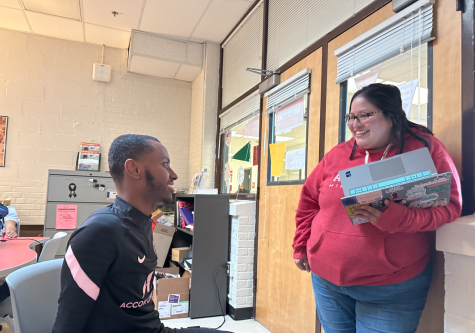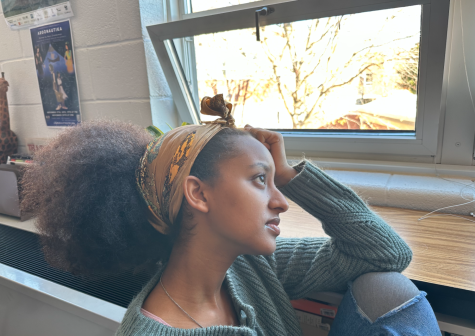Bounce your way to class with yoga ball chairs
Teacher switches traditional seats to more fun options
When senior Madison Schinstock walked into her IB Geography class, she was shocked by the sight of large, gray yoga balls spread around the room.
IB Geography and U.S. Government teacher Meagan Padgett had the great idea of replacing the stiff, plastic chairs with fun, bouncy yoga balls with the purpose of positively enhancing the students’ learning environment.
“I am in a grad school program for library science and one of the projects we’re working on is taking a physical library space and turning it into a more blended learning commons area,” Padgett said. “One of the big studies that I’ve been reading about was using more flexible seating options to make it a more student-centered space and I started thinking about the kind of benefits it could have in a classroom space too.”
After getting her idea approved by an administrator, Padgett started a DonorsChoose project to raise money for her idea. With support and donations, she was able to buy a classroom set of yoga balls, raising $450 in six days.
“I started looking into where it had been done in high schools and how it had been done in high schools and found that the schools who had done it had seen huge improvements in focus and concentration, test scores, reading comprehension and student engagement, so I decided to try it,” Padgett said.
According to a 2003 study published by the American Journal of Occupational Therapy, using yoga balls in a classroom setting improves behavior and legible word productivity. A 2007 study by the Mayo Clinic supported those claims and found additional benefits of a chairless classroom.
Although some may believe that introducing bouncy balls into a classroom may serve as a distraction, allowing students to move around while learning actually promotes greater focus and concentration, stopping students from falling asleep.
“For one thing, if they fall asleep they’re going to fall off. Having that slight error of danger I think keeps people a little more alert,” Padgett said. “One of the things that they do is they improve posture, core strength and circulation. So when your blood is circulating more it’s the same effect as if you’re up and walking around you’re less likely to feel tired or fall asleep.”
While the students are bouncing on their yoga balls, their brains are being more engaged and active. With more movement involved, neurological pathways are being sent from the body to the brain. As a result, the brain is forced to be more alert and attentive.
“I think it’s really fun and it makes class more interesting,” senior Ilhan Ahmed said. “It’s harder to fall asleep so that helps me more to focus.”
Still, the strangeness of having yoga balls in a classroom is hard to ignore for some students.
“I think it’s mostly just kind of weird. It’ll probably distract me in class,” senior Saad Farooq. “I’d rather have a regular chair with back support.”
In terms of posture, sitting on a large round ball in comparison to a chair forces students to sit up straight with both feet flat on the floor. With no back to rest against, students are more likely to sit up properly without leaning due to the need to maintain balance.
When students are sitting in their regular hard chairs, they often have their feet rested on the legs of the desks or are slouching in some sort of way.
This bad sitting posture only leads to negative effects like frequent back pain and excess pressure on the neck or shoulders. As a result, implementing yoga balls into the classroom will serve as a solution to these problems.
Another benefit of these yoga balls is that it incorporates physical activity into the students’ daily schedules (although it is a minimal amount). The constant bouncing on a ball helps burn off excess energy and with classes lasting around 90 minutes each, this could pose to be a positive opportunity for students aiming to lose some weight.
With the introduction of yoga balls into the classroom environment, most students have reacted positively despite some small nuances. Perhaps these advantages will encourage teachers to promote movement within classrooms and incorporate more active lessons. The advantages to this trend may result in expansion of yoga balls into the rest of the school.

Active member in various honor societies and clubs, senior Julie Nguyen has been on The A-Blast staff for three years. She is currently the Health Editor...









